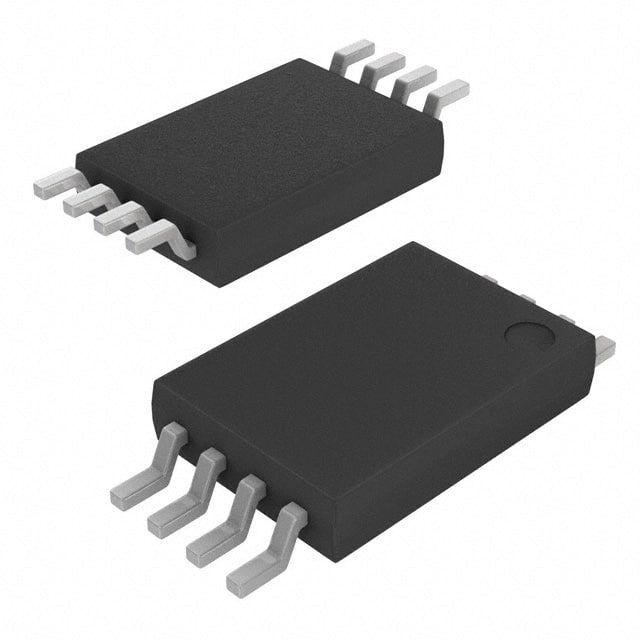MAX9767ETJ+T
Product Overview
- Category: Audio Amplifier
- Use: The MAX9767ETJ+T is a mono, 10W, filterless Class D audio power amplifier with volume control. It is designed to deliver high-quality sound in portable devices and other applications where space is limited.
- Characteristics: This amplifier offers high efficiency, low distortion, and a small package size, making it ideal for compact audio systems.
- Package: The MAX9767ETJ+T comes in a tiny 16-pin TQFN package, making it suitable for space-constrained designs.
- Essence: This amplifier provides a balance of performance and size, making it an attractive choice for portable audio applications.
- Packaging/Quantity: The MAX9767ETJ+T is typically available in reels of 2500 units.
Specifications
- Power Supply Voltage Range: 2.7V to 5.5V
- Output Power: 10W into 8Ω at 10% THD+N
- Efficiency: Up to 88%
- Signal-to-Noise Ratio (SNR): 106dB
- Operating Temperature Range: -40°C to +85°C
Detailed Pin Configuration
The MAX9767ETJ+T features the following pin configuration: 1. SHDN (Shutdown) 2. VDD (Power Supply) 3. GND (Ground) 4. IN+ (Positive Input) 5. IN- (Negative Input) 6. VREF (Reference Voltage) 7. AGND (Analog Ground) 8. OUT (Speaker Output)
Functional Features
- Volume Control: The MAX9767ETJ+T includes a digital volume control feature, allowing for easy adjustment of audio output levels.
- Filterless Operation: This amplifier operates without the need for external output filters, simplifying the design and reducing component count.
- Short-Circuit Protection: Integrated short-circuit and thermal-overload protection ensure the safety and reliability of the amplifier and connected components.
Advantages and Disadvantages
Advantages
- High efficiency
- Small package size
- Integrated volume control
- Filterless operation
Disadvantages
- Limited output power compared to some larger amplifiers
- Requires careful PCB layout to minimize noise and interference
Working Principles
The MAX9767ETJ+T utilizes Class D amplifier technology, which achieves high efficiency by rapidly switching the output transistors between fully on and fully off states. This approach minimizes power dissipation and heat generation while delivering high-quality audio output.
Detailed Application Field Plans
The MAX9767ETJ+T is well-suited for a range of portable and space-constrained audio applications, including: - Portable Bluetooth speakers - Headphone amplifiers - Compact audio systems for mobile devices - Automotive infotainment systems
Detailed and Complete Alternative Models
- MAX98306: A similar mono Class D amplifier with integrated volume control and filterless operation.
- TPA3116D2: A stereo Class D amplifier offering higher output power and flexibility for larger audio systems.
In conclusion, the MAX9767ETJ+T offers a compelling combination of performance and size for compact audio applications, making it a valuable choice for designers seeking high-quality audio amplification in constrained spaces.
10个与MAX9767ETJ+T在技术解决方案中的应用相关的常见问题及解答
What is the MAX9767ETJ+T?
- The MAX9767ETJ+T is a high-power, mono Class D amplifier with integrated volume control and dynamic range compression.
What is the maximum power output of the MAX9767ETJ+T?
- The MAX9767ETJ+T can deliver up to 20W into an 8Ω load or 40W into a 4Ω load.
What is the input voltage range for the MAX9767ETJ+T?
- The input voltage range for the MAX9767ETJ+T is typically between 4.5V and 14V.
How does the integrated volume control work in the MAX9767ETJ+T?
- The MAX9767ETJ+T features an integrated digital volume control that allows for precise adjustment of the audio level.
What is dynamic range compression in the context of the MAX9767ETJ+T?
- Dynamic range compression in the MAX9767ETJ+T helps to maintain consistent audio levels by reducing the difference between loud and soft sounds.
Can the MAX9767ETJ+T be used in automotive applications?
- Yes, the MAX9767ETJ+T is suitable for automotive audio systems due to its wide input voltage range and high-power output capabilities.
Does the MAX9767ETJ+T require external heat sinking?
- The MAX9767ETJ+T has a thermal shutdown feature and does not typically require external heat sinking under normal operating conditions.
What are the typical applications for the MAX9767ETJ+T?
- The MAX9767ETJ+T is commonly used in portable speakers, gaming headsets, and other audio amplification solutions.
What is the efficiency of the MAX9767ETJ+T?
- The MAX9767ETJ+T offers high efficiency, making it suitable for battery-powered applications where power consumption is a concern.
Is there a recommended layout for integrating the MAX9767ETJ+T into a PCB design?
- Yes, Maxim Integrated provides a recommended layout and application circuit in the MAX9767ETJ+T datasheet to ensure optimal performance and reliability.


